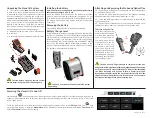
22
TU_US-BA-e-1714
Measuring hot surfaces
The sound velocity through a substance is dependent on its temperature. As materials
heat up, the velocity of sound through them decreases. In most applications with sur-
face temperatures of less than 100°C, no special procedures must be observed. At
temperatures above that point, the change in sound velocity of the material being
measured starts having a noticeable effect upon ultrasonic measurement. At such el-
evated temperatures it is recommended to first performing a calibration on a sample
piece of known thickness, which is at or near the temperature of the material being
measured. This will allow the instrument to correctly calculate the sound velocity
through the hot material.
When performing measurements on hot surfaces, it may also be necessary to use a
specially constructed high-temperature transducer. These transducers are built of ma-
terials which can withstand high temperatures.
It is also recommended that the sensor has to be left in contact with the surface for a
short time in order to aquire a stable measurement. While the transducer is in contact
with the hot surface, it will be heated up and with termal expansion and other effects,
the accuracy of measurement may adversely be affected.
Measuring laminated materials
Laminated materials are unique because of their density (and therefore sound velocity)
may considerably vary from one piece to another. Some laminated materials may even
exhibit noticeable changes in sound velocity across a single surface. The only way to
a reliable measurement is to perform a calibration on a sample piece of known thick-
ness. Ideally, this sample material should be a part of the same piece being measured,
or at least from the same lamination batch. The effects of variation of sound velocity
will be minimized by calibrating each test piece individually.
An additional important consideration is , that any included air gaps or air pockets will
cause an early reflection of the ultrasound beam. This will be noticed as a sudden
decrease in thickness in an otherwise regular surface. While this may impede accurate
measurement of the total material thickness, it does positively indicate any air gaps in
the laminate.
Suitability of materials
Ultrasonic thickness measurement relies on passing a sound wave through the mate-
rial being measured. Not all materials are suited to transmitting sound. Ultrasonic thick-
ness measurement is practically found in a wide variety of materials including metals,
plastic and glass.
Materials which are difficult include some cast materials, concrete, wood, fibreglass
and some rubber.


































